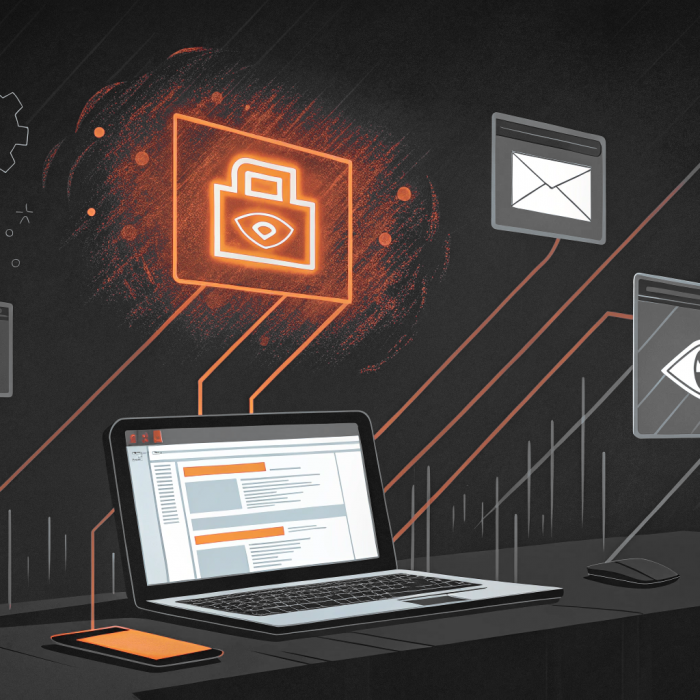Your recent LinkedIn post mentioned three department heads by name. Last week’s Instagram story shows you’re working late because the new software rollout hit snags. Yesterday’s Tweet was about how your IT department is overwhelmed with support tickets.
An attacker just spent five minutes building a detailed picture of your company’s current challenges, key personnel, and operational stress points. Now they’re crafting an email that will feel completely legitimate when it lands in your inbox.
These phishing attacks work because they’re personal. When someone emails you about a project you actually mentioned online, using the name of a coworker you recently tagged, your guard drops. The email doesn’t look like spam anymore, but like legitimate work communication.
How Attackers Research Their Targets
Cybercriminals approach social media like private investigators building a case. They collect information systematically, looking for specific details they can weaponize.
LinkedIn profiles reveal professional hierarchies. Attackers learn who you work with, what projects you’re involved in, and how your company operates. They see that you’re in accounting, that your manager reports to the CFO, and that you’ve been complaining about the new expense software rollout.
Facebook and Instagram show your personal side. Family photos reveal relationships. Check-ins show where you travel. Posts about your dog’s surgery or your daughter’s graduation give attackers emotional triggers they can exploit.
Twitter captures your personality and opinions. How you write, what annoys you, what excites you. Attackers use this to match your communication style when impersonating you or to know exactly which buttons to push.
The real damage happens when attackers cross-reference multiple platforms. Professional information from LinkedIn combined with personal details from Facebook creates a complete picture of who you are and how to manipulate you.

Ēxamples of Social Media Phishing Techniques
So what does this look like in practice? Here are a few ways that attackers might weaponize that information:
Boss Impersonation Using Travel Posts
An attacker sees that the CEO posted about attending a conference in Singapore. They also notice from a manager’s Facebook that she’s dealing with a family emergency. The attacker emails the finance team: “I’m in back-to-back meetings in Singapore and our CFO is unavailable. I need you to process this urgent vendor payment. I’ll explain more when I’m back, but the deadline is today.”
Vendor Spoofing Based on Company Updates
Multiple employees post about training sessions for new project management software. An attacker registers a domain similar to the software company’s website and sends emails about “immediate security patches” requiring login verification. The attack works because employees know the company really does use this software.
Personal Crisis Exploitation
An HR manager frequently posts about fundraising for her child’s medical treatment. An attacker creates a fake email from a “medical billing company” requesting updated insurance information to continue treatment authorization. The emotional urgency overrides normal security caution.
Protecting Your Digital Footprint
Here are practical steps to reduce your attack surface:
- Review your privacy settings across all platforms. Most social media sites default to sharing more than you probably want. Limit who can see your posts, photos, and personal information.
- Think about what you’re revealing before posting. That innocent photo from the company retreat shows attackers your workplace relationships. Location check-ins reveal travel patterns.
- Keep work and personal separate when possible. Use different platforms for different purposes. Don’t discuss work projects on personal accounts or share personal details on professional profiles.
- Be suspicious when urgent requests reference information from your social media. If someone emails about something they shouldn’t know based on your relationship with them, verify through alternative channels before responding.

When Phishing Prevention Fails
You can reduce the risk by training staff to recognize social engineering indicators and reduce how much information they share online. However, you can’t eliminate it entirely. Criminals are always developing new research techniques and attack methods.
Security professionals get fooled by these attacks. Executives fall for them. IT administrators click malicious links. The problem isn’t that people are stupid or careless. The problem is that these attacks exploit fundamental human psychology.
Smart security strategies assume that some attacks will eventually succeed. Instead of trying to create perfect humans who never make mistakes, focus on limiting damage when mistakes happen.
A More Effective Solution
Admin By Request’s Endpoint Privilege Management product works from this principle by removing permanent admin privileges from user accounts. Users get admin rights only when needed for specific tasks, then lose them automatically.
When someone falls for a well-crafted spear phishing email, attackers can’t immediately install malware or access sensitive systems. They hit a wall instead of gaining full system control.
Phishing attacks will keep getting more sophisticated and even security-aware employees can be manipulated. Some will eventually fall for attacks that use their own information against them. But that doesn’t have to translate into a data breach.
Interested in seeing our solutions in action? Book a demo today or download our Lifetime Free Plan to deploy them on up to 25 endpoints.







